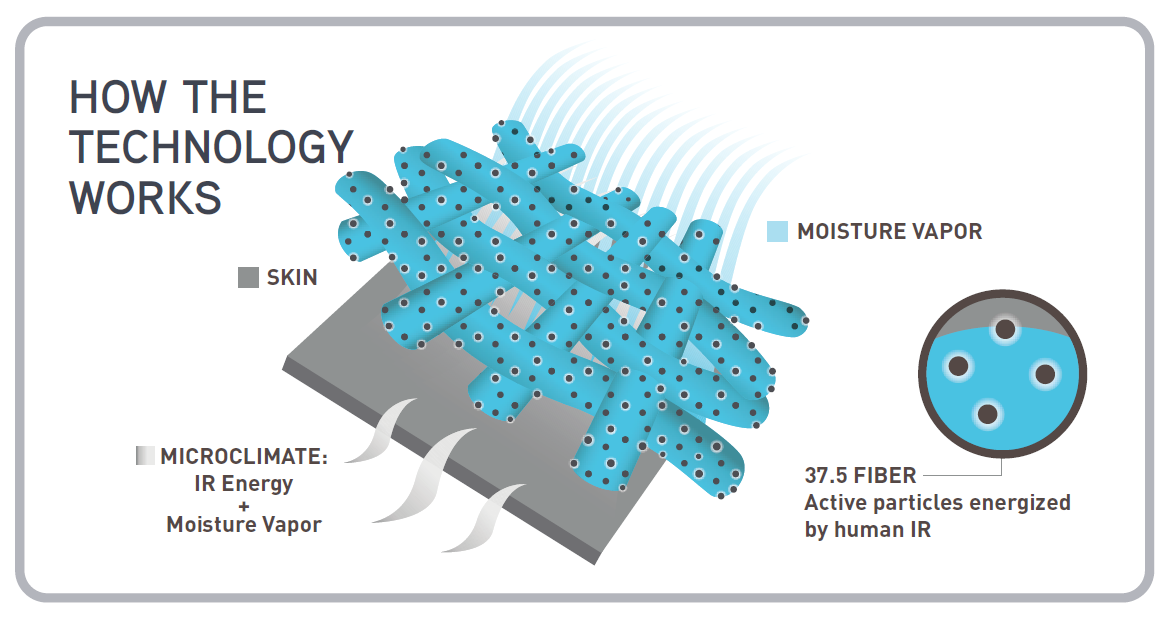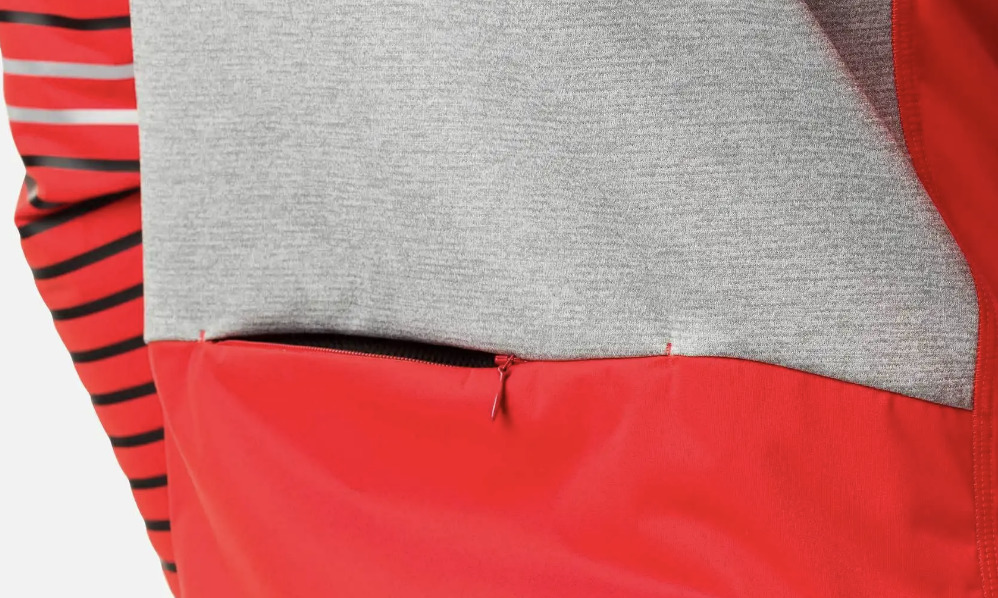Rossignol Poursuite Jacket
Test Duration: 65 miles
Test Locations: Marin, CA
Fabric: 100% polyester
Stated Features:
- “37.5 Technology” nylon with volcanic ash enhances thermoregulation and anti-stink properties
- Durable water repellent (DWR) finish
- Buttonholes for MP3
- Windproof “R-Wind” fabric
Fabric Weight: 82 g/m²
MSRP: $200
Size Tested: US Men’s Size Small
Reviewer: 5’9”, 150 lbs / 175 cm, 68 kg

Intro
Many readers will be familiar with Rossignol from their long and accomplished history manufacturing skis, but they’ve expanded their scope in recent years to include performance apparel and accessories for biking, hiking, and trail running (as well as actual bikes themselves). Much of the outwear options Rossignol offers are designed as multi-sport pieces, a versatility they leverage by identifying the similarities between aerobic sports like nordic skiing and running. Purists might balk at this premise, favoring a clean divide between gear for different sports, but there are no hard rules when it comes to what functions well on the trails, and Rossignol’s snowsports background privileges them to a way of thinking about running layers in a way that’s rare.
Rossignol’s full-zip Poursuite Jacket, a layer nominally created for Nordic skiing but that can be used for cold weather running, is just the latest example to prove the benefits of hybrid design. Cross-pollination between the two sports lends the Poursuite Jacket several features not typically seen on running apparel, including a tailored cut that ensures full range of motion, built-in moisture-wicking technology, windproof “R-Wind” fabric, and more. In this review, I’ll speak to what each of these characteristics adds to the Poursuite Jacket, where I think they could potentially hold it back as a layer exclusive to running, and why you might want to consider keeping one in your closet year-round.
Fit
Both running and nordic skiing require a significant amount of upper body movement. At high intensities, arm swing and torso rotation can put a lot of stress on tight-fitting tops intended to be aerodynamic and/or insulating. Ensuring ample range of motion is evidently one of Rossignol’s prime concerns when it comes to the Poursuite Jacket’s fit. My US Men’s Size Small bordered on baggy through the shoulders and arm holes before tapering slightly below my chest, coming to a rest a few inches below my waist in a way I’d liken to a pant leg on a straight-cut pair of jeans (though, unlike pant legs, the jacket’s waist can be tightened by synching an elastic cord at the bottom of the zipper). Rossignol describes this construction as “classic,” a “tailored cut inspired by sports ski style,” which I took vaguely to mean not as form-fitting as layers you’d typically see in the trail running space, and that checked out after my first couple of runs wearing it. While the jacket’s excess material definitely hurt its performance elsewhere, which I’ll touch on later, it did contribute to a feeling of freedom through the chest and shoulders that I think would be welcomed by trail runners who often feel restricted by less accommodating shirts / jackets.

Construction
As a multi-sport performance layer, the Poursuite Jacket’s design is appropriately involved to meet a diverse array of demands. It’s highlighted by a handful of premium materials that grant it the flexibility it needs to transition between skiing and running in everything from mild to moderate winter conditions. The jacket’s goal isn’t so much warmth as it is keeping you dry, so the majority of its construction is geared toward ventilation.
This starts first and foremost with Rossignol’s use of 37.5 Technology, a feature we praised in our review of the Janji Repeat Merino Tech Long Sleeve last month. In short, 37.5 Technology is a patented fabric technology that attracts the water vapor from sweat away from skin and expedites evaporation from clothing at faster rates than traditional fabrics, so the brand claims. Materials treated with 37.5 Technology receive ultra-porous volcanic minerals and coconut-derived activated carbon that absorb some of the infrared energy emitted by our bodies, in turn initiating 37.5 Technology particles to speed up evaporation. The increased surface area that fabrics treated with this application benefit from also supposedly expedites the removal of humidity.

The use of 37.5 Technology alone would make for some pretty impressive material, but Rossignol bolsters the Poursuite jacket’s construction further by adding their own proprietary “R-Wind” fabric weave along with a “Durable Water-Repellant” (DWR) coating, together giving the jacket a 10,000 mm waterproof and 25,000 mm breathable rating, respectively. The combination of these treatments surprisingly doesn’t feel like it adds a ton of weight to the material Rossignol uses. The jacket manages to escape feeling starchy and/or inflexible, a common pitfall of lightweight layers with a water-resistant membrane and/or DWR coating.
For storage, the Poursuite Jacket features two iPhone-sized zip pockets, one waist-level on the left-hand side and one beneath the jacket’s prominent stretch backpanel. I found the location of both to be tremendously awkward in practice. Much of my time testing the Poursuite Jacket was spent trying to think through the decision to only include one hand pocket instead of two collaterally, the latter of which I viewed as an intuitive type of design standard. I’m also pretty pessimistic when it comes to rear pockets on top layers (they’re my default favorite format on most running shorts, however). Keeping anything secured in the small of your back while out on the trails is a challenge in itself, especially if what you’re carrying weighs more than a gel or your ID / credit card. Of course, using both pockets is completely optional, and in the grand scheme of things their misplacement doesn’t take away from the Poursuite Jacket’s functionality, but it is a detail I think Rossignol missed the boat on. It’s also a decision made all the more vexing by the close attention they pay to other areas, like the buttonholes for headphones situated on the collar and smartly placed stretch back panel.
On Trail
I got my hands on the Poursuite Jacket while Northern California was still in the throes of an unprecedentedly wet winter. Atmospheric rivers arrived week after week, bringing cataracts of sideways rain and hail to our otherwise mild climate. Running in this type of weather loses its novelty after a few days. Once the warming excitement of a storm fades, I find that my body begins to reject the feeling of being wet and loses interest in being outside altogether. But I still need to take myself for a run regardless, and pieces like the Poursuite Jacket are indispensable to that end. A jacket with a 10,000 mm waterproof rating is not, in my opinion, high enough to act as a standalone layer when it’s truly raining (for context, standard Gore-Tex has a 28,000 mm rating), but it is enough to keep out condensation from fog and light drizzle (or some snow). I wore the Poursuite Jacket predominately on mornings like these, when I knew the darkening skies overheard were just an empty feint and all I should anticipate was minor precipitation. In this capacity, the jacket performed as you’d expect, considering its premium build quality. The DRW coating worked in tandem with 37.5 Technology to keep rain from soaking through while simultaneously pulling sweat away from my body, where it could then begin to evaporate. The addition of Rossignol’s R-Wind material rounded out the jacket’s strong weather resistance by cutting the chill carried by strong gusts on exposed sections of trail. Having your warmth carried off by a marauding wind can be defeating, and I think the Poursuite Jacket’s ability to hold onto heat from my core and limbs in the middle of a deluge is one of its best features.
I’ve seldom considered using a proper jacket as a midlayer for running. Most runners I know, myself included, warm up pretty quickly in starting temperatures near freezing and rarely ever don more than two layers (typically a wool long sleave and an ultralight shell, in my case). However, in light of the extreme weather events that have marked our winter in the Bay Area, I found myself feeling a bit unprepared and underclothed heading out the door each morning. After some trial and error, I settled into a pattern of adding the Poursuite Jacket in between my shell and baselayer on days when I knew I’d encounter rain. The lightweight polyester enhanced with 37.5 Technology was light enough and breathable enough to keep my temperature regulated, and the Poursuite Jacket’s relaxed fit preserved my full range of motion even when worn beneath an additional layer. The jacket’s water resistance rating was also able to supplement what my shell provided, meaning my upper body stayed dry even in the midst of sustained downpours.
Rossignol is on to something with the heavily engineered fabric they use for the Poursuite Jacket; it’s able to fend off many different types of weather while remaining lightweight and breathable. However, I think they could have approached the jacket’s cut differently. Though I appreciated their concern with preserving range of motion, the resulting fit billowed out more than I would have liked, hanging and bunching in areas under my arms and alongside my torso. I don’t suspect this was a sizing issue either, but moreso a result of how the jacket is tailored. While not a complete dealbreaker, I’ll likely reserve the Poursuite Jacket for use as a midlayer on really nasty days which, if this year is any indication, might be becoming more frequent.
Who’s It For?
I can’t speak to the Poursuite Jacket’s candidacy as a layer for Nordic skiing, but in the context of trail running, I think it has the potential to benefit an audience who’ve frequently been wronged by under layering in cold weather. Folks living in areas with mild to moderate winters could do well to reach for the Poursuite Jacket as a performance midlayer for frigid, dry conditions and stormy, wet days alike. Its 37.5 Technology polyester helps reduce overheating, even when worn under a hardshell, and the jacket’s 10,000 mm water-resistance rating helps it shield light precipitation and wind, while also potentially acting as a good complement when paired with higher-rated materials like Gore-Tex. That said, I think the bulkiness of the Poursuite Jacket’s fit, along with its oddly placed pockets, leave some room for improvement if considered as a standalone piece for running.
Bottom Line
Rossignol’s Poursuite Jacket demonstrates the hidden value of multisport apparel. Coming from a brand with a rich history of making equipment for snow sports, the influences the jacket takes from Nordic skiing translate pretty cleanly to cold weather running. Rossignol’s material of choice, wind-stopping polyester treated with a DWR coating and 37.5 Technology, grants the Poursuite Jacket high amounts of breathability and enough water resistance to handle mild drizzle and/or complement protection from a hardshell. While its generous fit and confusing storage configuration are enough to irritate, the jacket’s impressive performance as a midlayer softshell is reason enough to seek it out if you find yourself chronically underdressing.
